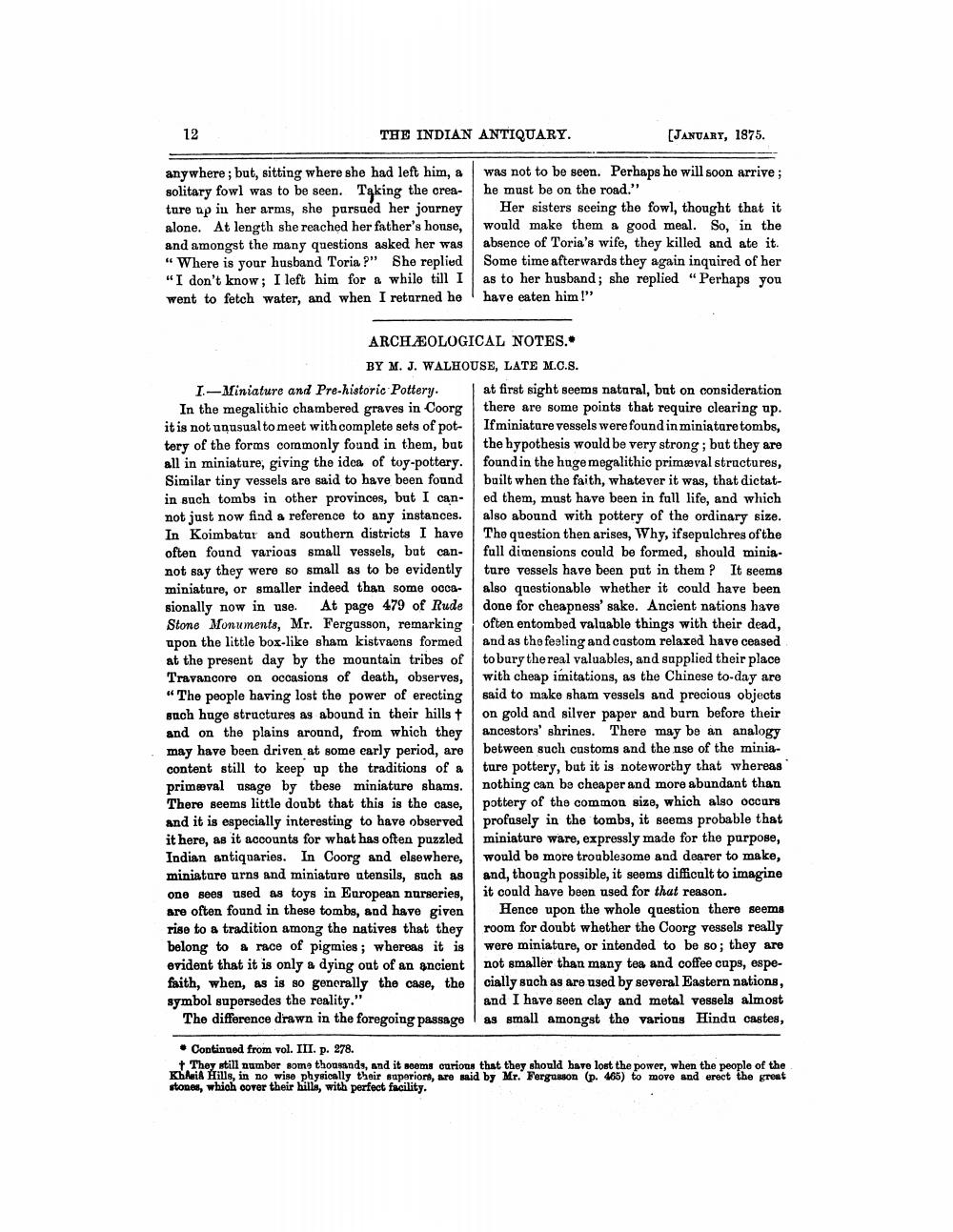________________
12
THE INDIAN ANTIQUARY.
(JANUARY, 1875.
anywhere; but, sitting where she had left him, a solitary fowl was to be seen. Taking the creature up in her arms, she pursued her journey alone. At length she reached her father's honse, and amongst the many questions asked her was " Where is your husband Toria ?" She replied "I don't know; I left him for a while till I went to fetch water, and when I returned he
was not to be seen. Perhaps he will soon arrive; he must be on the road."
Her sisters seeing the fowl, thought that it would make them a good meal. So, in the absence of Toria's wife, they killed and ate it. Some time afterwards they again inquired of her as to her husband; she replied "Perhaps you have eaten him!"
ARCHÆOLOGICAL NOTES.
BY M. J. WALHOUSE, LATE M.C.S. I.-Miniature and Pre-historic Pottery. at first sight seems natural, but on consideration In the megalithic chambered graves in Coorg there are some points that require clearing up. it is not unusualto meet with complete sets of pot- If miniature vessels were found in miniature tombs, tery of the forms commonly found in them, but the hypothesis would be very strong; but they are all in miniature, giving the idea of toy-pottery. found in the huge megalithic primäeval structures, Similar tiny vessels are said to have been found built when the faith, whatever it was, that dictatin such tombs in other provinces, but I can- ed them, must have been in full life, and which not just now find a reference to any instances. also abound with pottery of the ordinary size. In Koimbator and southern districts I have The question then arises, Why, if sepulchres of the often found various small vessels, but can- full dimensions could be formed, should minianot say they were so small as to be evidently ture vessels have been put in them? It seems miniature, or smaller indeed than some occa- also questionable whether it could have been sionally now in use. At page 479 of Rude done for cheapness' sake. Ancient nations have Stone Monuments, Mr. Fergusson, remarking often entombed valuable things with their dead, upon the little box-like sham kistvaons formed and as the feeling and castom relaxed have ceased at the present day by the mountain tribes of to bury the real valuables, and supplied their place Travancore on occasions of death, observes, with cheap imitations, as the Chinese to-day are "The people having lost the power of erecting said to make sham vessels and precious objects such huge structures as abound in their hillst on gold and silver paper and burn before their and on the plains around, from which they ancestors' shrines. There may be an analogy may have been driven at some early period, are between such customs and the nse of the miniacontent still to keep up the traditions of a ture pottery, but it is noteworthy that whereas primæval usage by these miniature shams. nothing can be cheaper and more abundant than There seems little doubt that this is the case, pottery of the common size, which also occurs and it is especially interesting to have observed profusely in the tombs, it seems probable that it here, as it accounts for what has often puzzled miniature ware, expressly made for the purpose, Indian antiquaries. In Coorg and elsewhere, would be more troublesome and dearer to make, miniature urns and miniature utensils, such as and, though possible, it seems difficult to imagine one sees used as toys in European nurseries, it could have been used for that reason. are often found in these tombs, and have given Hence upon the whole question there seems rise to a tradition among the natives that they room for doubt whether the Coorg vessels really belong to a race of pigmies; whereas it is were miniature, or intended to be so; they are evident that it is only a dying out of an ancient not smaller than many tea and coffee cups, espefaith, when, as is so generally the case, the cially such as are used by several Eastern nations, symbol supersedes the reality."
and I have seen clay and metal vessels almost The difference drawn in the foregoing passage as small amongst the various Hinda castes,
• Continued from vol. III. p. 278.
They still number some thousands, and it seems carious that they should have lost the power, when the people of the KHAA Hills, in no wise physically their superiors, are said by Mr. Ferguson (p. 465) to move and erect the great stones, which cover their hills, with perfect facility.




